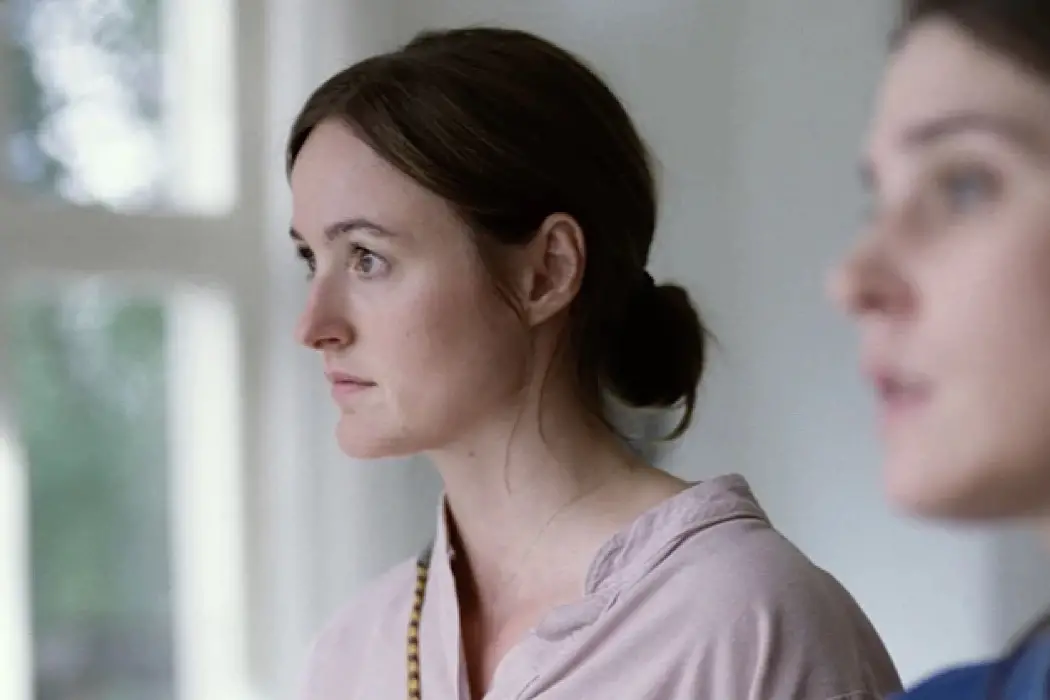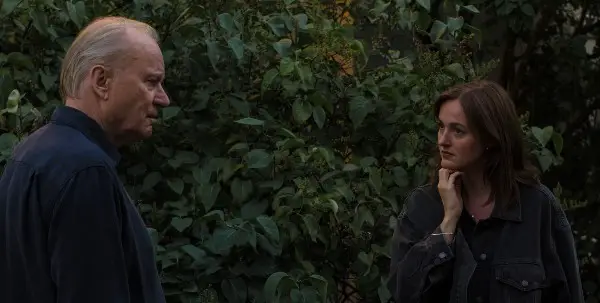LONDON FILM FESTIVAL 2025: SENTIMENTAL VALUE

All I know is that Oscar Isaac would make a…
God loves a Trier – Joachim, that is. Not content to bless the Danish-Norwegian writer and director with justified acclaim for his 2021 drama The Worst Person in the World, his follow up and latest, Sentimental Value, took home Cannes’ coveted Grand Prix.
Reuniting with Worst Person’s Renate Reinsve in the lead, Sentimental Value seems like another match made in heaven. There are angelic touches, blessed moments and stellar performances, but Trier’s Sentimental Value’s fragmented stories don’t allow it to hit the heights of his previous picture.
Several strands of a story
Reinsve plays Nora, an actor whose troubled relationship with her ageing auteur filmmaker father (Stellan Skarsgard) is troubled further when he asks her to play the lead in his new film. Amidst this, Nora’s sister Agnes (Inga Ibsdotter Lilleaas) navigates her relationship with Nora and their father, while Gustav enlists American actor Rachel Kemp (Elle Fanning) into the role Nora rejects, all framed within a loose narrative of the house the family has occupied for generations.
The film opens with the house, shown in astutely observed shots of the textures, alcoves and textures that kids, close to the ground and bored, are so familiar with. It immediately creates a sense of sentimentality, one might say. Of value, another might. The grooves in the floor made by years of an opening and closing door. Like the childhood scenes in Terrence Malick’s The Tree of Life, the camera keeps close to the ground, static or skittering along.

And our introduction to Nora is charming, energetic and fun. It’s opening night of The Seagull and she’s the lead. But her nerves possess her, sending her down a corridor, hurtling out an escape door, and onto lips of a cast mate. This is where she feels most alive, full of fear, yes, but full of life. It’s a funny scene, infused with a nervous, excited energy. But the promise of these openers – the astute visual observations of the house and the lively energy of the pre-showtime nerves – peters out, not to be recaptured or returned to.
Fragmentary structure that hinders the focus
Each of the story’s strands – the house, Nora and Gustav, Nora and Agnes, Rachel Kemp, Nora’s depression, Gustav’s mum – each stand alone, some more fleshed out than others. But, together, each feels fragmentary, almost like an anthology film with the through-line of the house attempting to bind it together.
Life is like this. Fragmentary and elliptical. A strand of something influences a decision, a recollection of grandparents filters into your thoughts, breaking off again just as quick. Half-forgotten things sometimes return to consciousness, a sort of closure sometimes arrives. Sentimental Value does capture that, but in a way this feels accidental, instead of something Trier is purposefully aiming for. What the film wants to be is a father-daughter story, Nora and Gustav, and in large part it is, but the other strands interfere with it.
The subplot of depression (a description which feels as flippant as the screen time it’s afforded) seems a particular disappointment because of its promise. Reinsve, somehow simultaneously an everywoman and uncommonly beautiful, pulls off the unrelenting deadness of feeling, the inability to summon the energy to even not be able to give a damn, with just a look. But then its over, she’s pulled out of because the story needs her to be thanks to the therapeutic abilities of art. The film is probably at its most interesting when exploring this art as therapy theme, but here in particular it feels cheap, as if just suggesting that if you can just find the right story – nevermind summoning the energy to read or care about it – you can pull yourself out of a mental illness.
Art as therapy
But the exploration of art as therapy mostly works. Gustav’s new script, written for Nora, is ostensibly about Gustav’s own mother but gradually we understand how much more it’s about Nora, who flat-out declines the role. But as we learn more about Nora we see how, though acceptance would be challenging and even risky, it may also be rewarding and cathartic.

A clue to this is found in a small scene where Nora cries in an acting class. But as it follows an emotional scene, and Trier starts close up on an upset Nora, we read it as Nora’s reaction to the previous scene. It’s only when the camera pulls back to reveal the rehearsal space that we understand Nora is performing. It’s an effective technique, enhanced by Reinsve’s performance. Is she using the emotional scene to allow herself to cry, disguising her own emotions as the character’s emotions? Is this how she permits herself to be emotional in front of other people, the way she doesn’t allow herself to be in front of her father? Is this why she’s an actor?
Remarkable Reinsve
Reinsve’s performance provokes not only these interesting questions but our sympathy throughout. She’s one of those actors whose presence you always feel entirely safe in, secure that nothing will be obvious nor overplayed, every choice engaging. Her eyes can signal recognition of something long withheld with a flicker, within her face that can be hard and mocking one moment, loving and warm the next.
Opposite her, Skarsgaard, Scandinavian cinema’s patriarch, embodies that contradiction of that relative we all know: displaying self-involved thoughtlessness with one person, yet observant kindness with another.
Conclusion
In the end, the only real value of any object or place is in its sentiment – the experiences, emotions and memories we imbue them with. If the performances are the rooms of Sentimental Value, they’re cosy, lived in, with interesting textures and furnishings. It’s the house – the overall story itself – that doesn’t stand as beautifully as it might’ve.
Sentimental Value will be released in November 2025.
Does content like this matter to you?
Become a Member and support film journalism. Unlock access to all of Film Inquiry`s great articles. Join a community of like-minded readers who are passionate about cinema - get access to our private members Network, give back to independent filmmakers, and more.













